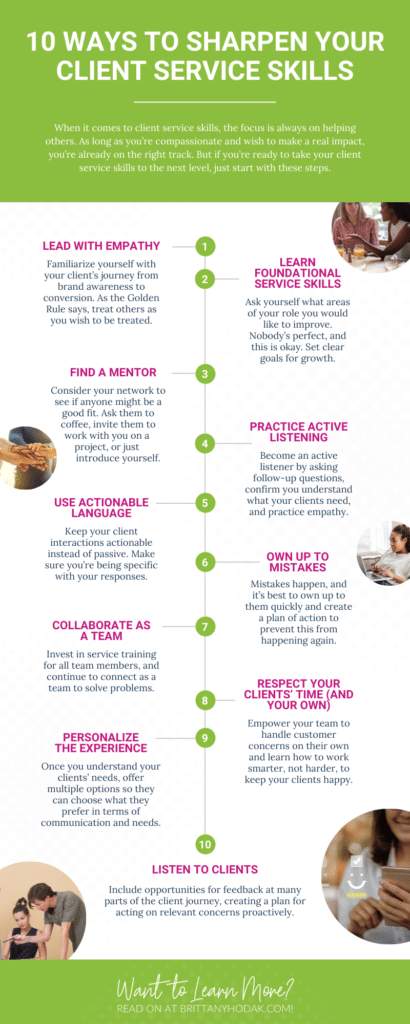When it comes to client service skills, the focus is always on helping others. As long as you’re compassionate and wish to make a real impact, you’re already on the right track. However, as anyone who works in client service or customer service knows, it’s always important to sharpen your client service skills.
How do you give the most to your clients without completely burning out? In addition, how do you continue to stay professional while sticking to clear boundaries? You can think of your skillset as a knife. While it might work great when you first get started, it eventually grows dull as you put it to use again and again. When you take the time to sharpen your client service skills (or sharpen the knife), you work more efficiently.
Though honing these skills takes time, it also pays off. In fact, 86% of positive client service turns one-time clients into long-term champions for your brand. This is what it means to grow superfans, and these are people who are ready to become partners in your success. As the saying goes, work smarter (not harder). Your time is precious, so it’s important to make sure you’re serving your clients in an influential, meaningful way without burning out your passion.
If you’re ready to take your client service skills to the next level, you don’t have to reinvent the wheel. This guide outlines 10 ways to sharpen your client service skills, no matter where you’re at in your brand journey. Above all, it’s about finding clear ways to create personal fulfillment through helping others.
1. Lead with empathy.
To begin, always lead with empathy. The human experience is something that’s easy to overlook, but it makes all the difference. It’s easy to recognize when a company treats client service interactions like numbers on a support page. In reality, each person has his or her own needs, expectations, and goals.
When you lead with empathy, you step into the shoes of the client. You understand who they are and what they want. Because you listen to customers and take their concerns seriously, you take their feedback seriously. By leading with empathy, you appeal to your clients’ humanity, showing them that you value them as individuals.
Next steps: Take the time to familiarize yourself with your client’s journey from brand awareness to conversion. Identify problem areas and tension in advance, acting proactively to anticipate these problems before they occur. As the Golden Rule says, treat others as you wish to be treated.
2. Learn foundational service skills.
Next, take the time to learn (or re-learn) foundational service skills. No matter how long you’ve been in this industry, we can all use a refresher from time to time. Another important thing to note is that customer and client expectations are always changing. If you want your client service skills to be top-notch, you can never stop learning.
There are so many ways to keep learning. This doesn’t have to be expensive or complicated. Here are some free or low-cost ideas to sharpen your skills:
- Take an online course
- Read a book on service
- Follow a client service blog for industry news
- Attend a professional event or seminar
- Watch service-focused videos online
- Learn from other company’s mistakes
Next steps: Ask yourself what areas of your role you would like to improve. Nobody’s perfect, and this is okay. Set clear goals for growth that are attainable over time.
3. Find a mentor.
Another important way to sharpen your client service skills is to find a mentor in your space. Your brand doesn’t exist in a vacuum. By using a mentor or consultant, you bring in an outside perspective for fresh ideas and innovation. It’s easy to feel stuck if you’re doing the same things over and over. It’s okay to bring in help.
How can you find a mentor or consultant? Network in your community, look for online leaders, and connect with other professionals. If you find others with a proven record of success, don’t be afraid to reach out. You’d be surprised how willing people can be to help if you just ask.
Next steps: Consider your own community and network to see if anyone might be a good fit. Ask them to coffee, invite them to work with you on a project, or just introduce yourself.
4. Practice active listening.
While it’s easy to listen to client concerns, how often do you actually hear what they’re saying? Though it’s easy to overlook, active listening is the foundation of communication and service. When you’re an active listener, you actually understand what your customer says and their feelings behind the words. More importantly, you make each client feel like they’re valued.
A reported 3 out of 5 consumers report good service as the key that keeps them loyal to a brand. This means it’s never been more important to become an active listener in every interaction. Behind every client is a real person. Though sometimes they have real problems they want to be fixed, usually they just want to feel heard.
If you’re an active listener, customers tell you everything you need to know. They have ideas about how you should improve, what’s working for them, and how you can take your products/services further. If you want raving fans, you need to be an active listener.
Next steps: Become an active listener by asking follow-up questions, confirm you understand what your clients need, and practice empathy.
5. Use actionable language.
Next, did you know there are “good” and “bad” words when it comes to client service? If you want to sharpen your client service skills, you need to know what to say—and what not to say. As you already learned, active listening is essential for any brand. While most use phrases like “the customer is always right” or “never say no,” this isn’t necessarily the most effective method.
Unfortunately, there are no magic words, but you can use actionable language to drive real action and empathy. By leading with empathy, using specific words, and repeating the client’s own words back to them, you show you see them as real humans.
For example, you could respond to a client’s complaint with something passive like: “I’m sorry that happened. It won’t happen again.” Alternatively, you can lean into action-based language with something like: “That sounds really frustrating, and I’m really sorry you were disappointed. I’m going to review this tech issue with the IT team right away.”
Next steps: Keep your client interactions actionable instead of passive. Make sure you’re being specific with your responses. Actions speak louder than words, so be positive your words match your actions.
6. Own up to mistakes.
Similarly, never play the blame game. As we said, words matter. Always own up to mistakes and take responsibility when appropriate. It’s easy to pass blame along to another department, shipping partner, or even the customer. While this might get the blame of you temporarily, it’s a dead-end street to client frustration.
Customers are savvier than ever before. They recognize when things go wrong, and they expect brands to take accountability. In fact, it can even help your brand to own up to mistakes. For example, a reported 94% of customers are likely to show loyalty to a brand that stays transparent.
Next steps: Recognize that nobody is perfect, not even big-name companies. Mistakes happen, and it’s best to own up to them quickly and create a plan of action to prevent this from happening again.
7. Collaborate as a team.
Another important way to sharpen your client service skills is by encouraging collaboration. Client service doesn’t belong in a silo. It’s not only the responsibility of your service team. It’s an entire brand’s job to ensure clients’ expectations are met, so it’s never been more important to collaborate.
By collaborating as a team, you ensure all teams have the same information to pass along to customers. We all understand how frustrating it is to be told different things by different support staff. Beyond this, all team members from IT to leadership know how to handle client interactions with confidence.
Next steps: Invest in service training for all team members, and continue to connect as a team to solve problems.
8. Respect your clients’ time (and your own).
Just as you want others to respect your time, make sure you practice what you preach. You can do this by focusing your undivided attention on them, showing them that you really care. If something goes wrong, respond promptly. Be proactive about delays and things that might slow down the process.
Aside from treating them the way you’d like to be treated, keep your promises and stay personal. Ensure your clients feel heard, understood, and important. Everyone wants to feel special. No client wants their time wasted. Respecting your clients’ time is a two-way street. You also should set firm boundaries around your own time to avoid burning out.
Next steps: Empower your team to handle customer concerns on their own, limiting the tension between interactions. Additionally, learn how to work smarter, not harder, to keep your clients happy.
9. Personalize the experience.
Next, it’s never been more important to personalize the experience. Your clients don’t want to feel like a number on a page. They want to be valued, and they want to feel unique. The customer experience has never mattered more, and it doesn’t have to be complicated. How can you do this?
- Profiles: Develop customer profiles to understand who your customers are and what they need from you.
- Choices: While most people know the Golden Rule, the Silver Rule is sometimes more important: treat others the way they want to be treated. When you give customers choices (like phone, text, or email support), they feel more comfortable.
- CRM: A Customer Relationship Management (CRM) system improves your service and personalization at a wide level.
- Self-service: Many customers today expect self-service tools like chatbots, FAQs, and support guides. Creating an omnichannel approach to service only helps your team.
With 80% of customers more likely to make a purchase from a brand with a personalized experience, this is an important trend. If you want to succeed today, you need to lead with humanity.
Next steps: Once you understand your clients’ needs, offer multiple options so they can choose what they prefer in terms of communication and needs.
10. Listen to clients.
Lastly, your clients’ feedback is the most important asset you have. Your clients know where you need to improve better than you, and that means you need to take their words seriously. You can pay attention to key metrics, run surveys, or simply ask your clients how they feel. It’s easy to assume you know best, but this is a slippery slope.
Instead of making assumptions, ask for real-world feedback. Pay attention to reviews and support tickets. Most importantly, act on this feedback. Create a real strategy for collecting client feedback and make real changes. When customers see you acting on their feedback, they know you really care.
Next steps: Include opportunities for feedback at many parts of the client journey, creating a plan for acting on relevant concerns proactively.
Ready to Sharpen Your Skills?
Now that you’ve read through these 10 ideas above, how do your current client service skills match up? Are you ready for the new era of customer service? Is your brand currently attracting (and retaining) superfans?
If not, you still have time. By implementing these 10 ideas above, you put empathy in the driver’s seat. Not only do you learn how to handle client problems more effectively, but you become proactive instead of reactive. Not only does this make your brand more successful, but your clients will take notice.

